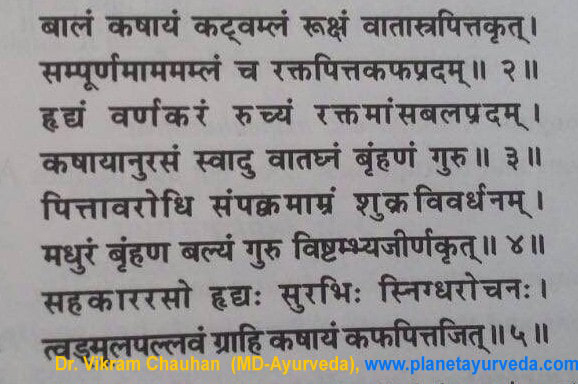Mango (Mangifera indica) - Uses, Benefits, Dosage and Properties

Who does not like eating mangoes or its various dishes, desserts and smoothies? I know one of my family members who is allergic to this amazing fruit and it is hard to understand the plight.
I have used this example just too literally to emphasize the amazing goodness of the rich flavor of mango fruit in its various stages. Different parts of this plant which can be used for multiple purposes. Fruits, seeds, pulp, bark, leaves, roots and almost any part of the plant are used for medicinal purpose.
"Aam" as is commonly known in Hindi is Mangifera indica botanically. It is a tree belonging to the Anacardiaceae family. Let us here have a look at the amazing medicinal properties of Aam. Leaves and bark of mango is rich in mangiferin, mangiferolic acid, homonangiferin and indicenol. Young leaves contains tannins, flavonoids, steroids, cardiac glycosides, alkaloids and carbohydrates.
Description of Plant
Mango tree is evergreen and erect growing up to 20-45mt in height with oval, upright, dome shaped crown and stout trunk. Mango tree is long lived, known to be 250-300 years with fruits. Leaves of this tree are linear - oblong, lanceolate, elliptical, pointed from both sides and arranged on branches in spiral pattern and have soothing aroma. Red, yellow and green colored flowers occurs in panicles about 3000 in number. Fruit of this plant is large drupe, but differ in shape and size. Yellowish green ripen fruits contains yellow thick pulp with single seed. Seed is oblong, solitary and covered by hard covering.
Habitat
Mango is native to South Asia and cultivated from thousand years back. It is distributed throughout world in tropical and subtropical warm climates. Almost world's half mangoes are cultivated in India and second country is China. It is also found in Central America, South, West and Central Africa, South Korea, Bangladesh and Pakistan. Large variety of diseases also affect this fruit.
Classification
- Kingdom - Plantae
- Order - Sapindales
- Family - Anacardiaceae
Common Synonyms of Mangifera indica
- English name - Mango
- Hindi name - Aam
- Sanskrit name - Aamra, Sahakara, Madhavadrum, Bhringabeeshta, Parapushta, Pikabandhava, Rasala, Madhuphala, Madhuli etc.
There are many more synonyms given to this plant in honour of the various medicinal benefits that it has for the mankind.
Ayurvedic Properties
| Hindi / Sanskrit | English | ||
| Rasa | Kashaya | Taste | Astringent |
| Guna | Laghu | Physical Property | Light |
| Virya | Sheet | Potency | Cold |
| Vipaka | Katu | Metabolic Property (After Digestion) | Pungent |
Effects on Doshas
Ripen fruit balances vata dosha. Other parts balances kapha and pitta dosha.
| Charak Samhita | Sushrut Samhita | Vagbhata | Bhavprakash |
|
Nyargodhadi group. | Nyargodhadi group | Amaradi group |
Ancient Verse about Mangifera indica


According to first shalok chuta, rasala, kiresta, madirasakha, kamanga, shakara, parapusta and madhudhbhva are various synonyms of mango.
According to second shalok unripe fruit is astringent, pungent, sour, ruksa, aggravates pitta dosha and leads to bleeding diathesis. Old sour fruit leading to bleeding diathesis and aggravates kapha dosha. Sweet and old fruit is beneficial for the heart, appetizer, nutritious, heavy, tonic and pacifies vata dosha. Ripe fruit pacifies pitta dosha, act as sweet, tonic, nutritious heavy and leads to tympanites. Mango juice is beneficial aromatic, snigdha, appetizer and act as heart tonic. Outermost covering, leaves have kashya rasa and used to pacify pitta and kapha dosha.
Practical Uses of Mango
Mango fruit undergoes different stages of development like any other fruit or plant part but, at its various stages exhibit different properties which if understood well can serve a diverse medicinal purpose.
- Unripe Mango - Pungent, astringent, sour to taste, dry and balances vata and pitta doshas. It is great for improving taste and anorexia. Mango pickles are usually made of these unripe sour fruits to serve as mouthwatering appetizers in Indian food.
- Sour Mango - Due to its extremely sour flavor, it is said to worsen blood disorders like raktapitta (gout), bleeding and menstrual disturbances.
It improves kapha and is great for the heart.
Also improves skin complexion and tone while relieving anorexia and throat disorders.
Sour mango is also a great immunity booster and enhances muscular strength.
- Sweet Mango - With a predominantly sweet and a slight astringent taste, this is the best stage of mango fruit for balancing vata disorders like neuralgia, constipation, paralysis and bloating.
It is slightly heavy to digest and nourishing for the body.
Sweet mango is a great aphrodisiac and improves immunity and strength.
Overall, it has a very nourishing and calming effect on the body.
Mango tree bark has astringent properties which make it useful to pacify kapha and pitta disorders.
Roots of this tree can treat IBS and Diarrhea.
Mango young leaves also show similar effects.
The flowers can be used to purify blood naturally and is also useful in gastric problems, anorexia, diarrhea, & IBS etc. It is also useful in UTI and Diabetes.
Ripened Mango with milk serves as a great aphrodisiac.
Similarly, using the above mentioned basic parts of Mango tree, a myriad of dishes and recipes can be prepared which can be put to use for mending many health problems.
Mango oil is used in oral health issues.
External application of Mango parts can help hasten wound healing and prevent bleeding from fresh injuries.
Caution
- Weaken digestive system
- Recurrent chronic fever
- Skin disorders and bleeding disorders
- Constipation and bloating
- Eye disorders
Products from this Herb
- Patrangasav
- Nyagrodhadi churna
Part Used
- Stem bark
- Leaf
- Flower
- Seed kernel
Dosage
- Fresh Juice - 10 - 20 ml.
- Decoction - 50 -100 ml.
- Seed Powder - 3 - 6 gm.



